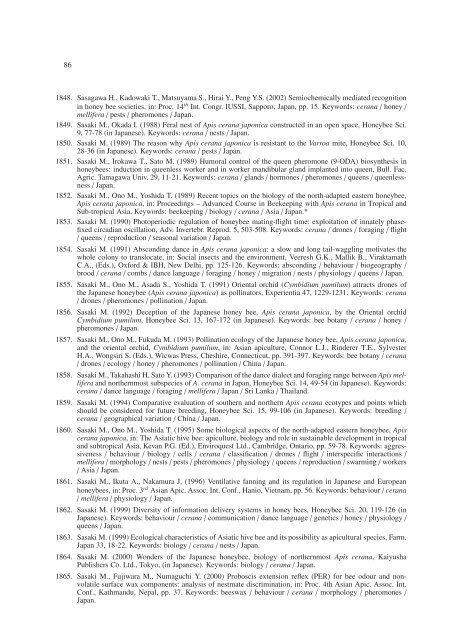Bibliography of Apis cerana Fabricius - Apidologie
Bibliography of Apis cerana Fabricius - Apidologie
Bibliography of Apis cerana Fabricius - Apidologie
Create successful ePaper yourself
Turn your PDF publications into a flip-book with our unique Google optimized e-Paper software.
86<br />
1848. Sasagawa H., Kadowaki T., Matsuyama S., Hirai Y., Peng Y.S. (2002) Semiochemically mediated recognition<br />
in honey bee societies, in: Proc. 14th Int. Congr. IUSSI, Sapporo, Japan, pp. 15. Keywords: <strong>cerana</strong> / honey /<br />
mellifera / pests / pheromones / Japan.<br />
1849. Sasaki M., Okada I. (1988) Feral nest <strong>of</strong> <strong>Apis</strong> <strong>cerana</strong> japonica constructed in an open space, Honeybee Sci.<br />
9, 77-78 (in Japanese). Keywords: <strong>cerana</strong> / nests / Japan.<br />
1850. Sasaki M. (1989) The reason why <strong>Apis</strong> <strong>cerana</strong> japonica is resistant to the Varroa mite, Honeybee Sci. 10,<br />
28-36 (in Japanese). Keywords: <strong>cerana</strong> / pests / Japan.<br />
1851. Sasaki M., Irokawa T., Sato M. (1989) Humoral control <strong>of</strong> the queen pheromone (9-ODA) biosynthesis in<br />
honeybees: induction in queenless worker and in worker mandibular gland implanted into queen, Bull. Fac.<br />
Agric. Tamagawa Univ. 29, 11-21. Keywords: <strong>cerana</strong> / glands / hormones / pheromones / queens / queenlessness<br />
/ Japan.<br />
1852. Sasaki M., Ono M., Yoshida T. (1989) Recent topics on the biology <strong>of</strong> the north-adapted eastern honeybee,<br />
<strong>Apis</strong> <strong>cerana</strong> japonica, in: Proceedings – Advanced Course in Beekeeping with <strong>Apis</strong> <strong>cerana</strong> in Tropical and<br />
Sub-tropical Asia. Keywords: beekeeping / biology / <strong>cerana</strong> / Asia / Japan.*<br />
1853. Sasaki M. (1990) Photoperiodic regulation <strong>of</strong> honeybee mating-flight time: exploitation <strong>of</strong> innately phasefixed<br />
circadian oscillation, Adv. Invertebr. Reprod. 5, 503-508. Keywords: <strong>cerana</strong> / drones / foraging / flight<br />
/ queens / reproduction / seasonal variation / Japan.<br />
1854. Sasaki M. (1991) Absconding dance in <strong>Apis</strong> <strong>cerana</strong> japonica: a slow and long tail-waggling motivates the<br />
whole colony to translocate, in: Social insects and the environment, Veeresh G.K., Mallik B., Viraktamath<br />
C.A., (Eds.), Oxford & IBH, New Delhi, pp. 125-126. Keywords: absconding / behaviour / biogeography /<br />
brood / <strong>cerana</strong> / combs / dance language / foraging / honey / migration / nests / physiology / queens / Japan.<br />
1855. Sasaki M., Ono M., Asada S., Yoshida T. (1991) Oriental orchid (Cymbidium pumilum) attracts drones <strong>of</strong><br />
the Japanese honeybee (<strong>Apis</strong> <strong>cerana</strong> japonica) as pollinators, Experientia 47, 1229-1231. Keywords: <strong>cerana</strong><br />
/ drones / pheromones / pollination / Japan.<br />
1856. Sasaki M. (1992) Deception <strong>of</strong> the Japanese honey bee, <strong>Apis</strong> <strong>cerana</strong> japonica, by the Oriental orchid<br />
Cymbidium pumilum, Honeybee Sci. 13, 167-172 (in Japanese). Keywords: bee botany / <strong>cerana</strong> / honey /<br />
pheromones / Japan.<br />
1857. Sasaki M., Ono M., Fukuda M. (1993) Pollination ecology <strong>of</strong> the Japanese honey bee, <strong>Apis</strong> <strong>cerana</strong> japonica,<br />
and the oriental orchid, Cymbidium pumilum, in: Asian apiculture, Connor L.J., Rinderer T.E., Sylvester<br />
H.A., Wongsiri S. (Eds.), Wicwas Press, Cheshire, Connecticut, pp. 391-397. Keywords: bee botany / <strong>cerana</strong><br />
/ drones / ecology / honey / pheromones / pollination / China / Japan.<br />
1858. Sasaki M., Takahashi H, Sato Y. (1993) Comparison <strong>of</strong> the dance dialect and foraging range between <strong>Apis</strong> mellifera<br />
and northernmost subspecies <strong>of</strong> A. <strong>cerana</strong> in Japan, Honeybee Sci. 14, 49-54 (in Japanese). Keywords:<br />
<strong>cerana</strong> / dance language / foraging / mellifera / Japan / Sri Lanka / Thailand.<br />
1859. Sasaki M. (1994) Comparative evaluation <strong>of</strong> southern and northern <strong>Apis</strong> <strong>cerana</strong> ecotypes and points which<br />
should be considered for future breeding, Honeybee Sci. 15, 99-106 (in Japanese). Keywords: breeding /<br />
<strong>cerana</strong> / geographical variation / China / Japan.<br />
1860. Sasaki M., Ono M., Yoshida T. (1995) Some biological aspects <strong>of</strong> the north-adapted eastern honeybee, <strong>Apis</strong><br />
<strong>cerana</strong> japonica, in: The Asiatic hive bee: apiculture, biology and role in sustainable development in tropical<br />
and subtropical Asia, Kevan P.G. (Ed.), Enviroquest Ltd., Cambridge, Ontario, pp. 59-78. Keywords: aggressiveness<br />
/ behaviour / biology / cells / <strong>cerana</strong> / classification / drones / flight / interspecific interactions /<br />
mellifera / morphology / nests / pests / pheromones / physiology / queens / reproduction / swarming / workers<br />
/ Asia / Japan.<br />
1861. Sasaki M., Ikuta A., Nakamura J. (1996) Ventilative fanning and its regulation in Japanese and European<br />
honeybees, in: Proc. 3rd Asian Apic. Assoc. Int. Conf., Hanio, Vietnam, pp. 56. Keywords: behaviour / <strong>cerana</strong><br />
/ mellifera / physiology / Japan.<br />
1862. Sasaki M. (1999) Diversity <strong>of</strong> information delivery systems in honey bees, Honeybee Sci. 20, 119-126 (in<br />
Japanese). Keywords: behaviour / <strong>cerana</strong> / communication / dance language / genetics / honey / physiology /<br />
queens / Japan.<br />
1863. Sasaki M. (1999) Ecological characteristics <strong>of</strong> Asiatic hive bee and its possibility as apicultural species, Farm.<br />
Japan 33, 18-22. Keywords: biology / <strong>cerana</strong> / nests / Japan.<br />
1864. Sasaki M. (2000) Wonders <strong>of</strong> the Japanese honeybee, biology <strong>of</strong> northernmost <strong>Apis</strong> <strong>cerana</strong>, Kaiyusha<br />
Publishers Co. Ltd., Tokyo, (in Japanese). Keywords: biology / <strong>cerana</strong> / Japan.<br />
1865. Sasaki M., Fujiwara M., Numaguchi Y. (2000) Proboscis extension reflex (PER) for bee odour and nonvolatile<br />
surface wax components: analysis <strong>of</strong> nestmate discrimination, in: Proc. 4th Asian Apic. Assoc. Int.<br />
Conf., Kathmandu, Nepal, pp. 37. Keywords: beeswax / behaviour / <strong>cerana</strong> / morphology / pheromones /<br />
Japan.




